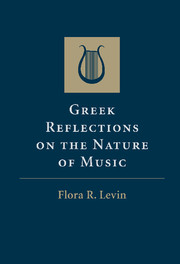Book contents
- Frontmatter
- Contents
- Figures
- Preface
- Introduction
- Abbreviations
- Texts
- 1 All Deep Things Are Song
- 2 We Are All Aristoxenians
- 3 The Discrete and the Continuous
- 4 Magnitudes and Multitudes
- 5 The Topology of Melody
- 6 Aristoxenus of Tarentum and Ptolemaïs of Cyrene
- 7 Aisthēsis and Logos: A Single Continent
- 8 The Infinite and the Infinitesimal
- ΣΦPAΓIΣ
- Bibliography
- Index
4 - Magnitudes and Multitudes
Published online by Cambridge University Press: 21 October 2009
- Frontmatter
- Contents
- Figures
- Preface
- Introduction
- Abbreviations
- Texts
- 1 All Deep Things Are Song
- 2 We Are All Aristoxenians
- 3 The Discrete and the Continuous
- 4 Magnitudes and Multitudes
- 5 The Topology of Melody
- 6 Aristoxenus of Tarentum and Ptolemaïs of Cyrene
- 7 Aisthēsis and Logos: A Single Continent
- 8 The Infinite and the Infinitesimal
- ΣΦPAΓIΣ
- Bibliography
- Index
Summary
A quantity is a multitude
if it can be numbered;
but it is a magnitude if it can be measured.
Aristotle, Metaphysics 1020a8–10in the opening lines to book ii of war and peace, tolstoy offered the following insight on the continuity of motion:
By adopting smaller and smaller elements of motion we only approach a solution to the problem, but never reach it. Only when we have admitted the conception of the infinitely small, and the resulting geometrical progression with a common ratio of one tenth, and have found the sum of this progression to infinity, do we reach a conclusion to the problem.
This is almost exactly what Aristoxenus did. As he conceived the problem of melodic motion or, as he put it, the motion of the singing voice, it was only by taking infinitesimally small units for measurement and attaining to the art of integrating them – that is, finding the sum of these infinitesimals – that he was he able to arrive at the laws of melodic consecution. The common ratio commanding the infinitely small basic elements of his progression was one-twelfth. In working toward this goal, Aristoxenus contrived to break down the mathematically logical opposition between magnitude (megethos) and multitude (plēthos), in effect, between geometry and arithmetic. The very nature of his method invited him to believe that he could achieve his goal without altering the nature of scientific reasoning. Directly inspired by his knowledge of Pythagorean theory, he discovered a completely new way of dealing with musical intervals: he substituted arithmetic for geometry. It was necessary for him to do this if he wished to extend mathematically rigorous methods to problems where no quantity was involved.
- Type
- Chapter
- Information
- Greek Reflections on the Nature of Music , pp. 121 - 153Publisher: Cambridge University PressPrint publication year: 2009

